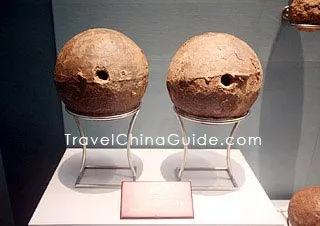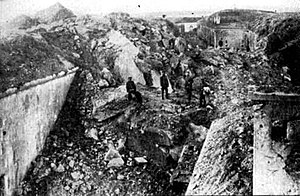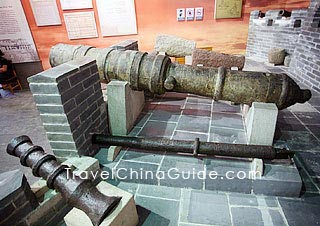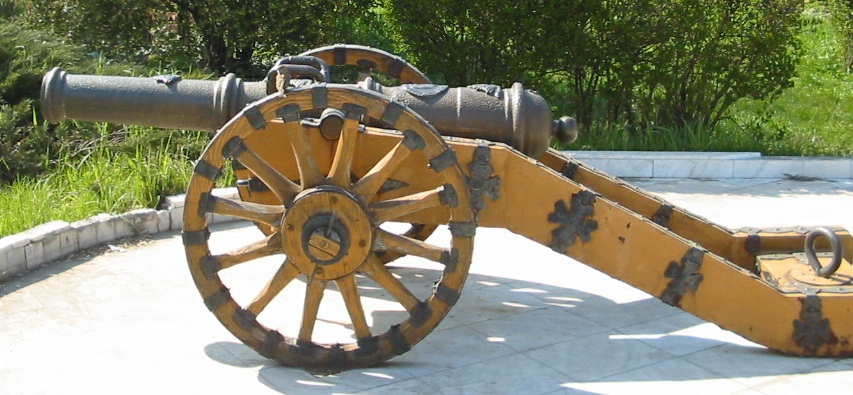Ancient cannons were mainly used in a warfare called siege. Siege is when an invading force surronds a city and waits until the city's inhabintants surrender due to lack of resources. Cannnons, were very effecive at this because the cannon's could destroy resource deposits, important buildings, walls, bridges, and anything else that might halt a siege. Because of sieges, many cities have fallen, and losing cities is how nations fall. When a nation falls, the conquering nation becomes stronger, and the conquered nation's allies weaken due to loss of trade, both imports and exports. Some examples are: Siege of Vicksburg, Siege of Leningrad, Siege of St. Petersburg, Siege of Yorktown, Siege of Boston, Siege of Vienna, and the Siege of Paris.
Also, building cannon's provided economic support for the producing country. In the United States during World War II, war resources, including cannons, were being mass produced for the Allied front. Citizen's were being paid money to donate and to recycle steel and other metals to produce things made of steel.
Friday, February 4, 2011
Works Cited
http://www.travelchinaguide.com/intro/focus/weaponry-post.htm
http://en.wikipedia.org/wiki/Smoothbore
http://en.wikipedia.org/wiki/Mortar_(weapon)
http://www.nps.gov/archive/gett/soldierlife/artillery.htm
http://www.thefinertimes.com/Weapons-of-War/weapons-used-in-the-war-of-1812.html
http://www.firstworldwar.com/atoz/bigbertha.htm
http://en.wikipedia.org/wiki/14%22/50_caliber_railway_gun
http://en.wikipedia.org/wiki/Quadratic_equation#Quadratic_formula
http://www.google.com/images
http://en.wikipedia.org/wiki/Smoothbore
http://en.wikipedia.org/wiki/Mortar_(weapon)
http://www.nps.gov/archive/gett/soldierlife/artillery.htm
http://www.thefinertimes.com/Weapons-of-War/weapons-used-in-the-war-of-1812.html
http://www.firstworldwar.com/atoz/bigbertha.htm
http://en.wikipedia.org/wiki/14%22/50_caliber_railway_gun
http://en.wikipedia.org/wiki/Quadratic_equation#Quadratic_formula
http://www.google.com/images
Wednesday, February 2, 2011
World War II Cannon Advancements
In World War Two, the advancement of cannons exploded. Cannons were put on ships, tanks, trucks, and even airplanes. They were used from artillary support to vehicle or ship destroyers to city liberators. Even though this was the greatest advancement of cannons, they wer becoming less noticable, since they were no longer cast iron, muzzle loaded tubes of iron that fired with a fuse but steel killing machines. They came in various sizes, from mortars to .70 caliber guns to howitzers to anti-aircraft cannons to large artillary.
Monday, January 31, 2011
World War One Cannons
World War One was the beginning of major cannon improvments. Howizters, mortars, and other large cannons were improved, and some were made mobile to make tanks.

Mortars were in the beginning process of becoming the small cylinder shaft they are today.

Howitzers came in many sizes for man y different purposes.
Mortars were in the beginning process of becoming the small cylinder shaft they are today.
Howitzers came in many sizes for man y different purposes.
Also, the machine gun was made, which was considered a cannon.
US Navy Mk 4 14 inch/50 caliber gun - Largest Allied gun of World War I
The US Navy Mk 4 14 inch/50 caliber guns were used on the rail ways to defeat the Germans in the closing months of World War I.
"Upon its entry into the war, the US chose its largest and longest-ranged available naval gun to fill the gap - the 14"/50 caliber Mk 4 gun with a muzzle velocity of 2800 feet per second. The new 16-inch gun would have been preferable, but it was not yet available in numbers; spare 14-inch guns kept for the active fleet were used instead.
Baldwin Locomotive Works delivered five trains for the United States Navy during April and May 1918. Each train transported and supported a 14"/50 caliber Mk 4 gun mounted on a rail carriage with four 6-wheel bogies.
There was some doubt as to whether the Flanders coast and French Channel ports were now safe Allied ports following the German Spring offensive successes in March and April 1918 which brought those areas within German artillery and attack range. The guns were therefore diverted from the British zone in the north to further south, to the port of St. Nazaire, to avoid the risk of having such valuable assets captured or destroyed.
Each battery composed of a locomotive, gun car, ammunition cars, supporting equipment cars, and accommodation cars for the crew was under the command of a United States Navy lieutenant, and under overall command of Rear Admiral Charles Peshall Plunkett. After delivery by ship, these trains were assembled in St. Nazaire in August.\
Before a gun arrived at a firing position, a curved length of track was laid at a position calculated suitable for firing at a specific target, and a pit 9 feet deep involving the removal of 103 cubic yards of earth was dug between the rails into which the gun recoiled 44 inches. Supports were also embedded in this pit connected to the gun mounting, to transmit remaining recoil energy directly to the ground and avoid placing excessive vertical strain on the gun car (and, through it, the track) and prevent it from moving backwards. In fact, by late 1918 the French had already constructed many such curved spurs (épis) for their own guns and hence the US guns were often able to re-use these.
The gun car was positioned over the pit, the wheels were locked and the platform was locked into position with gun mount and car's weight shifted from the trucks (bogies) directly to the ground by jacks and lifting screws. The gun could elevate up to 43° which gave it a maximum range of 42,000 yards (23.8 miles/38.4 km), and could be traversed 2.5° left and right of center. Any greater change of direction required the gun to be moved forward or backward along its curved track and a new recoil pit dug. The gun used the standard naval gun mounting and recoil system, with the addition of a pneumatic system to assist the runout springs to return the gun to firing position after recoil at the higher maximum elevation of 43° compared to maximum 30° in naval use.
A major disadvantage of the Mark I mount was that the weight was distributed forward, placing weight on the leading axles that was above the normally allowable weight for French railways and also caused axle bearings to overheat at any speed over 5 - 10 mph. The armored enclosed gun house lacked ventilation and caused condensation to form which promoted rusting. The necessity to excavate a recoil pit was also not acceptable as a longterm solution of recoil control. Hence Mark I, while functioning as designed, was seen as only a compromise measure necessitated by wartime time constraints.
The guns served to support General Pershing's army offensive in the Meuse-Argonne sector of the Western Front in France. They operated as single-gun batteries designated Battery 1 - Battery 5. Battery 2 commanded by Lieutenant (JG) E D Duckett, US Navy, had the distinction of being the first all-US gun (crew, gun and ammunition) to fire in action on the Western Front. On 6 September 1918 they fired from the forest of Compiegne at the important German railway center of Tergnier in support of an Allied attack.
The guns were used to target key infrastructure deep behind the German lines such as railway junctions and other lines of communication and concentration, typically only opening fire after an Allied attack had begun to avoid giving the Germans any warning of Allied intentions.
They fired a total of 782 shells on 25 separate active days on the Western Front at ranges between 27 and 36 kilometers. This equated to an average of 156 rounds per gun, which was approximately half the 300 rounds expected life of these guns before they would need refurbishment. The guns were only fired for specific strategic purposes to conserve barrel life, with smaller guns being used whenever possible. Hence on many days they remained inactive or were being moved.
The last shot was fired by Battery 4 at 10:57:30 am on 11 November 1918, timed to land just before the scheduled Armistice at 11 am.
One of these guns is on display outside the U.S. Navy Museum at the Washington Navy Yard."
"Upon its entry into the war, the US chose its largest and longest-ranged available naval gun to fill the gap - the 14"/50 caliber Mk 4 gun with a muzzle velocity of 2800 feet per second. The new 16-inch gun would have been preferable, but it was not yet available in numbers; spare 14-inch guns kept for the active fleet were used instead.
Baldwin Locomotive Works delivered five trains for the United States Navy during April and May 1918. Each train transported and supported a 14"/50 caliber Mk 4 gun mounted on a rail carriage with four 6-wheel bogies.
There was some doubt as to whether the Flanders coast and French Channel ports were now safe Allied ports following the German Spring offensive successes in March and April 1918 which brought those areas within German artillery and attack range. The guns were therefore diverted from the British zone in the north to further south, to the port of St. Nazaire, to avoid the risk of having such valuable assets captured or destroyed.
Each battery composed of a locomotive, gun car, ammunition cars, supporting equipment cars, and accommodation cars for the crew was under the command of a United States Navy lieutenant, and under overall command of Rear Admiral Charles Peshall Plunkett. After delivery by ship, these trains were assembled in St. Nazaire in August.\
Before a gun arrived at a firing position, a curved length of track was laid at a position calculated suitable for firing at a specific target, and a pit 9 feet deep involving the removal of 103 cubic yards of earth was dug between the rails into which the gun recoiled 44 inches. Supports were also embedded in this pit connected to the gun mounting, to transmit remaining recoil energy directly to the ground and avoid placing excessive vertical strain on the gun car (and, through it, the track) and prevent it from moving backwards. In fact, by late 1918 the French had already constructed many such curved spurs (épis) for their own guns and hence the US guns were often able to re-use these.
The gun car was positioned over the pit, the wheels were locked and the platform was locked into position with gun mount and car's weight shifted from the trucks (bogies) directly to the ground by jacks and lifting screws. The gun could elevate up to 43° which gave it a maximum range of 42,000 yards (23.8 miles/38.4 km), and could be traversed 2.5° left and right of center. Any greater change of direction required the gun to be moved forward or backward along its curved track and a new recoil pit dug. The gun used the standard naval gun mounting and recoil system, with the addition of a pneumatic system to assist the runout springs to return the gun to firing position after recoil at the higher maximum elevation of 43° compared to maximum 30° in naval use.
A major disadvantage of the Mark I mount was that the weight was distributed forward, placing weight on the leading axles that was above the normally allowable weight for French railways and also caused axle bearings to overheat at any speed over 5 - 10 mph. The armored enclosed gun house lacked ventilation and caused condensation to form which promoted rusting. The necessity to excavate a recoil pit was also not acceptable as a longterm solution of recoil control. Hence Mark I, while functioning as designed, was seen as only a compromise measure necessitated by wartime time constraints.
The guns served to support General Pershing's army offensive in the Meuse-Argonne sector of the Western Front in France. They operated as single-gun batteries designated Battery 1 - Battery 5. Battery 2 commanded by Lieutenant (JG) E D Duckett, US Navy, had the distinction of being the first all-US gun (crew, gun and ammunition) to fire in action on the Western Front. On 6 September 1918 they fired from the forest of Compiegne at the important German railway center of Tergnier in support of an Allied attack.
The guns were used to target key infrastructure deep behind the German lines such as railway junctions and other lines of communication and concentration, typically only opening fire after an Allied attack had begun to avoid giving the Germans any warning of Allied intentions.
They fired a total of 782 shells on 25 separate active days on the Western Front at ranges between 27 and 36 kilometers. This equated to an average of 156 rounds per gun, which was approximately half the 300 rounds expected life of these guns before they would need refurbishment. The guns were only fired for specific strategic purposes to conserve barrel life, with smaller guns being used whenever possible. Hence on many days they remained inactive or were being moved.
The last shot was fired by Battery 4 at 10:57:30 am on 11 November 1918, timed to land just before the scheduled Armistice at 11 am.
One of these guns is on display outside the U.S. Navy Museum at the Washington Navy Yard."
"Big Bertha" - German World War I Howitzer
Although the name was commonly applied to a whole variety of large-calibre German artillery guns the "Big Bertha" actually referred to a single siege gun, at that time the world's largest and most powerful.
Produced by the German company of Krupp, the Big Bertha was a 42cm howitzer, model L/14 designed in after the Russo-Japanese War of 1904 for the German Army. It was initially used as a means of demolishing the fortress towns of Liege and Namur in August 1914, the first month World War I. It was thereafter used to similarly reduce other enemy strong-points as the need arose.
The somewhat unflattering name itself arose from association with the wife of Gustav Krupp, owner of the Krupp factory. Her name was Bertha Krupp von Bohlen und Halbach.
Only four Big Bertha howitzers were produced, the first two rolling off the production line a mere matter of days after the onset of hostilities, on 9 August 1914. Once constructed these huge guns, whose shells weighed 820kg each, were shipped in their constituent parts by tractor to their destination point where they were once again reassembled by a huge crew of as many as 1,000 men.
With a range of 15km their 420mm shells proved devastating and all four were used during the German assault upon Verdun from February 1916.
Once the Verdun offensive was called off in failure, the Big Bertha guns were decommissioned, since Allied artillery developments had resulted in guns with a longer range.
Thursday, January 27, 2011
War of 1812 Cannon Information
"On the other hand, cannons which were the artilleries weapons used in the war of 1812 were utilized for the bombardment of buildings and perimeter defenses of the other side prior to assault of the attacking forces.
Cannons were of several kinds. There were cannons designed for use aboard ships which were the specialty of the British naval forces during those periods. Cannons for use on land were known as the early mortars that can carry cannon balls to far distances. Cannons that would comprise an attacking force were called artilleries. These cannons were movable carried on wooden wheel contraptions and carried to its location by horses.
There were several models or types of cannons that the British and American forces used to fight each other. These types of cannons would depend on the poundage of the cannon balls that they can carry.
But although these kinds of artillery or cannons were devastating weapons used in the war of 1812, they were still hampered by the lack of accuracy. In fact there were cases when the round of cannon balls fired on a target is nearly used up but the target is still standing without being hit. Both the British and the American forces have their own artilleries but they greatly depend more on the muskets and rifles with bayonets that their soldiers have to win their battles."
Cannons were of several kinds. There were cannons designed for use aboard ships which were the specialty of the British naval forces during those periods. Cannons for use on land were known as the early mortars that can carry cannon balls to far distances. Cannons that would comprise an attacking force were called artilleries. These cannons were movable carried on wooden wheel contraptions and carried to its location by horses.
There were several models or types of cannons that the British and American forces used to fight each other. These types of cannons would depend on the poundage of the cannon balls that they can carry.
But although these kinds of artillery or cannons were devastating weapons used in the war of 1812, they were still hampered by the lack of accuracy. In fact there were cases when the round of cannon balls fired on a target is nearly used up but the target is still standing without being hit. Both the British and the American forces have their own artilleries but they greatly depend more on the muskets and rifles with bayonets that their soldiers have to win their battles."
Civil War Cannon's description and role
"Artillery in the 1800's fought side by side with infantry units because the range of the big guns limited them to visible targets. Like the infantry weapons, Civil War-era cannon were muzzle loaders and required a crew of eight men to aim, load, and fire the weapon. Maintaining the large guns was an important job and discipline in the artillery was very strict due to the value of the weapon. One artillery unit was referred to as a battery. Composed of six cannon and just over one hundred men, the battery was commanded by a captain. Many batteries were companies of an artillery regiment. Battery A, 4th US Artillery or Battery B, 1st New York Light Artillery are examples of this. Some northern states raised "independent" batteries, which were not attached to an artillery regiment. New York supplied fifteen independent batteries including Captain Andrew Cowan's 1st New York Battery and Captain Patrick Hart's 15th New York Battery, both of which fought at Gettysburg. "
Thursday, January 20, 2011
Pre - 1800's Cannons
"In the Northern Song Dynasty (960-1127), gunpowder began to be used in weaponry and the earliest experience in the world. In the Compendium of Military we can determine that there were three production methods for cannonballs which were hurled by a stonejacker as in the Three Kingdoms Period.
In the Southern Song Dynasty (1127 - 1279), Records of Defending Cities by Chen Gui showed the earliest use of flame throwers. People at that time held powder in a thick bamboo tube that spewed fire out of it to burn enemies.
The shooting fire weapon Huo Chong made of metal came out in the Yuan Dynasty (1271 - 1368). It was the predecessor of firearms. When soldiers used it, they usually foisted powder into the powder chamber, fixed the powder wick and the stones, and then lit to shoot. In the following dynasty Ming (1368-1644), it played an important role in wars and was the most advanced weapon world wide. Huo Chong with larger calibre evolved to be the cannon, and the one with small caliber to be guns. |
| Iron Bombs |
Although weapons once occupied the top place, they didn't develop much further according to the Training Records (or Lian Bing Shi Ji) by Qi Jiguang cold weapons were still dominant. While after powder spread in the Western world, firearms were quickly employed and until the merchantmen of Spain and Holland brought the latest ones in the late Ming dynasty, the Chinese had not realized their lack of development. The imported cannons in the Qing Dynasty had a high reputation such as 'Great General in Red'. However in the late Qing, it fell again behind during the confrontation between westerners and Chinese."
Thursday, January 13, 2011
Cannon Designs
The early cannon designs were a vase-like shape made out of cast iron. "A smoothbore weapon is one which has a barrel without rifling" - Wikipedia. All cannons are smoothbore, so the projectile can come out more effeciently. Also, the first cannons were muzzle-loaded, which means they were loaded from the front of the barrel, not the back.
A howitzer is a type of artillery that has a short barrel and the use of small propellant charges to propel projectiles at high trajectories, with a steep angle of descent.
A mortar is a cannon that fires indirectly that fires shells at low velocities, short ranges, and high-arcing ballistic trajectories. It is typically muzzle-loading and has a barrel length less than 15 times its caliber.
The type of amuuntion today are high explosive, illuminate, white phosphorus, and armor piercing.
A howitzer is a type of artillery that has a short barrel and the use of small propellant charges to propel projectiles at high trajectories, with a steep angle of descent.
A mortar is a cannon that fires indirectly that fires shells at low velocities, short ranges, and high-arcing ballistic trajectories. It is typically muzzle-loading and has a barrel length less than 15 times its caliber.
The type of amuuntion today are high explosive, illuminate, white phosphorus, and armor piercing.
Subscribe to:
Comments (Atom)




